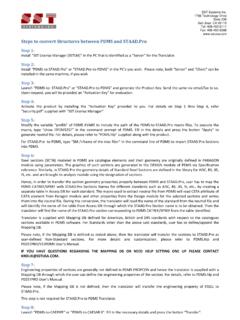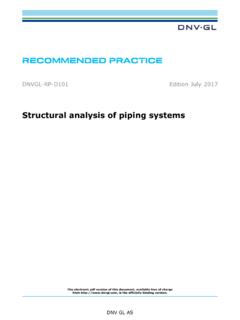Transcription of Basic - CAEPIPE, pipe stress analysis software / piping ...
1 Basic Pipe stress analysis Tutorial Visit our website SST Systems, Inc. SST Basic Pipe stress analysis Tutorial, Version , 2011 - 2014, SST Systems, Inc. All Rights Reserved. Disclaimer Please read the following carefully: CAEPIPE and this tutorial have been developed and checked for correctness and accuracy by SST Systems, Inc. However, no warranty, expressed or implied, is made by the authors or by SST Systems, Inc., as to the accuracy and correctness of the tutorial or the functioning of CAEPIPE and the accuracy, correctness and utilization of its calculations. Users must carry out all necessary tests to verify CAEPIPE calculations, and the applicability of their results. All information presented by CAEPIPE is for review, interpretation, approval and application by a Registered Professional Engineer.
2 CAEPIPE is a trademark of SST Systems, Inc. All other product names mentioned in this document are trademarks or registered trademarks of their respective companies/holders. SST Systems, Inc. 1798 Technology Drive, Ste. 236 San Jose, CA 95110, USA Tel: (408) 452 8111 Fax: (408) 452 8388 SST Systems, Inc. 1 Basic Pipe stress analysis Tutorial Good, relevant and no n-o ver whelming techni cal in formation on pipe stre ss analysis is hard to come by. So, we decid ed to pr ovide a simple tutori al on the basics of pipi ng stre ss analysis . This tutorial is dire cted towards newcomers to Pipe stress analysis ju st as much as to engineers new to CAEPIPE. To get the full benefit from this tutorial, you will need a working copy of CAEPIPE, pipe stress analysis software . Download a Free Copy of CAEPIPE here CAEPIPE - Features and Benefits Useful learning resources: CAEPIPE Tutorial 1 CAEPIPE Tutorial 2 CAEPIPE Users Manual Pipe stress Tips Archive The piping Journal Blog You are welcome to use any other pro gram if you choo se to.
3 Tutorial: Table of Contents A Technical Article on the Bas ic Concepts A Preliminary Pi pe stress analysis Procedure Five simple, illustrative ex amples, four of which build upon the previous ones Example 1 - Using Expansion Loops Example 2 - Splitting Thermal Growth Example 3 - Axial Restra ints to Direct Thermal Growth Example 4 - Locating Supports For Deadweight analysis Example 5 Making layout Changes to Reduce Thermal Stresses Pipe stress analysis : Basic Concepts Introduction It is common practice worldwide for piping de sig ners to route pipi ng by con sid er ing mainly spac e, pro cess an d flow constra ints (s uc h as pr essure drop ) and other requi remen ts aris ing from cons tru ctabilit y, op erability and rep ara bility. Unfortunately, pipe stre ss an alysis requi rements are often not sufficiently consid er ed while routing an d sup porti ng piping systems, especially in providi ng adequate flexibility to ab sor b expansion/contractio n of pipe s due to ther mal loads.
4 So, when as designed piping systems are handed-off to pipe stre ss en gi nee rs for detail ed an aly sis, they soon realiz e that the systems are stif f an d suggest routing chang es to make the systems more flexibl e. The piping de sig ne rs, in turn, make changes to routing an d send the re vised layout to the pipe stress engi neers to check for compli anc e again. Such back and forth design iterat ions betwee n layout and stre ss de pa rtments continue until a suitab le layout and support sche me is arrived at, resulting in sign ifican t in crease in proje ct ex ecution time, whic h, in turn, in creases pro ject costs. This delay in pro ject execution is furt her worsened in recent years by incre ased oper ating pressures and temperature s in order to in crease pl ant output; in creased operating pressure s incre ase pipe wall thic kne sses, which, in turn , in crease piping stif fnes ses furt he r.
5 Such increa sed operating tempera tures applied on s tiffer systems increa se pipe ther mal stre sses an d supp ort l oads. So, it is all the more impo rtant to make the piping layout flexible at the time of routing. (C hec kStress, SST s add-on pro du ct for PDMS and Cadmatic dire ctly addre sses an d sol ves this problem). SST Systems, Inc. 2 Types of Loads piping systems expe ri en ce dif feren t types of load in gs, categ or iz ed in to three ba sic lo ad in g types Sustain ed , Thermal and Occasional loads. Sustained Loads These mainly cons ist of in ternal pressure and dead-weight. Dead- weight is from the weight of pip es, fittin gs, components such as val ves, operating fluid or test flui d, in sulation , cladd in g, lin ing etc. Inter nal design or operating pressure caus es uni form circ umferential stresses in the pipe wall, ba sed on which a pipe wall thickness is de termined during the pro cess/P&ID stage of plant design .
6 Addit ionall y, internal pressure gi ves rise to ax ial stre sses in the pipe wall. Since these axial pres sure stre sses vary only with pressure, pi pe diameter and wall thic kness (all three of which are pre set at the P&ID stage), thes e stres ses cannot be al tered by cha nging the piping layout or the suppor t scheme. A pipe s de adweight caus es it to bend (g ene rally downward) be tween suppor ts and noz zles, producing axial stre sses in the pipe wall (al so called b ending stresses ) which vary linearly acro ss the pipe cro ss-section, be in g tensil e at either the top or bottom surface and compre ssive at the other surfac e. If the pipi ng system is no t sup po rt ed in the vertical dire ction ( , in the gr avity direction) ex cepting equipment noz zles, bend ing of the pipe due to deadweight may de velop excessive stresses in the pipe and impose large loads on equip ment nozzles, the reby incre as ing its susceptibi lity to fai lure by collapse.
7 Vario us international piping stan da rd s/cod es impose stre ss limit s, also called allowable stresses for sustained loads, on these axial stre sses gene rated by de ad weight and pre ssure in order to avoid fai lur e by collap se. For the calculated actual stresses to be below such allowable stre sses for sustained loads, it may be necessary to suppo rt the piping system vertically. Typical vertical supports to carry de adwei ght are: Varia ble spr ing hang ers Constant supp ort hange rs Rod ha ng ers Resting steel sup po rts. Rod hange rs and resting stee l supp orts fully restrain downward pipe movement but permit pi pe to lift up . A coup le of ex amples are pre sented in this tutorial to illustra te ho w piping can be suppor ted by spring hangers and resting steel sup po rt s to comply with the code requirements for sustained loads.
8 Thermal Loads (Expansion Loads) These refer to the c yclic thermal ex pansion or con tracti on of pipin g as it goes from one thermal state to another (for example, from shu t- down to normal opera tion and then ba ck to s hu t-d own ). If the piping system is not re strai ned in the thermal growth/contrac tion dire ctions (for example, in the axial direction of pi pe ), then, for such cyclic the rmal load, the pipe expands/contra cts fre ely ; in this case, no in terna l forces, moments and re sulting stresses and stra in s are ge ne ra ted in the piping system. If, on the other hand, the pipe is restrained in the di re ctio ns it wants to thermally deform (such as at equipment no zzles and pipe supp orts), such cons traint on free thermal de for mation genera tes cyclic ther mal stre sses and strains throughout the system as the system go es from one thermal state to ano ther.
9 When such calc ula ted thermal stre ss ranges exceed the allowable thermal stress ra nge specifi ed by various international piping standa rd s/code s, then the system is susceptib le to failu re by fatigue. So, in orde r to avoid fatigue fai lu re du e to cyclic thermal loads, the piping system shou ld be made flexible (and not stif f). SST Systems, Inc. 3 This is normally accomplis hed as follows: a) Introduce bends/elbows in the layout , as bends/ elb ows ovalize when bent by end moments, which increases piping flexibility. b) Introduce as much offset as possible between equipment nozzles (which are normally modeled as anchors in pipe stress analyses). For example, if two equipment noz zles (which are to be connected by piping ) are in lin e, then the straight pipe connecting these noz zles will be very sti ff . If, on the other hand, the two equipment are located with an offset, then their nozzles wil l have to be connected by an L shaped pipeline which includes a bend/elbow; such L shaped pipeline is much mor e flexible than the straight pip eline mentioned above.
10 C) Introduce expansion loops (with each loop consisting of four bends/elbows) to absorb the rmal growth/contraction. d) Lastly, introduce expansion joints such as bellows, slip joints etc, if warranted. In addition to generati ng thermal stress ranges in the piping system, cyclic thermal loads impose lo ads on static and rotatin g equipment nozzles. By following one or more of the steps from (a) to (d) given ab ove an d steps (e) and (f) given below, such noz zle loa ds can be reduced. e) Introduce axial restraints (which res train pipe in its axi al direction) at appropriate locations such that thermal gro wth/contraction is dir ected away from nozzles. f) Introduce intermediate anchors (which restrain pip e movement in the thr ee translational and thr ee rotational directions) at appropriate loc ations such that thermal deformation is absorbed by regions (such as expansion loops) away from equipment nozzles.

